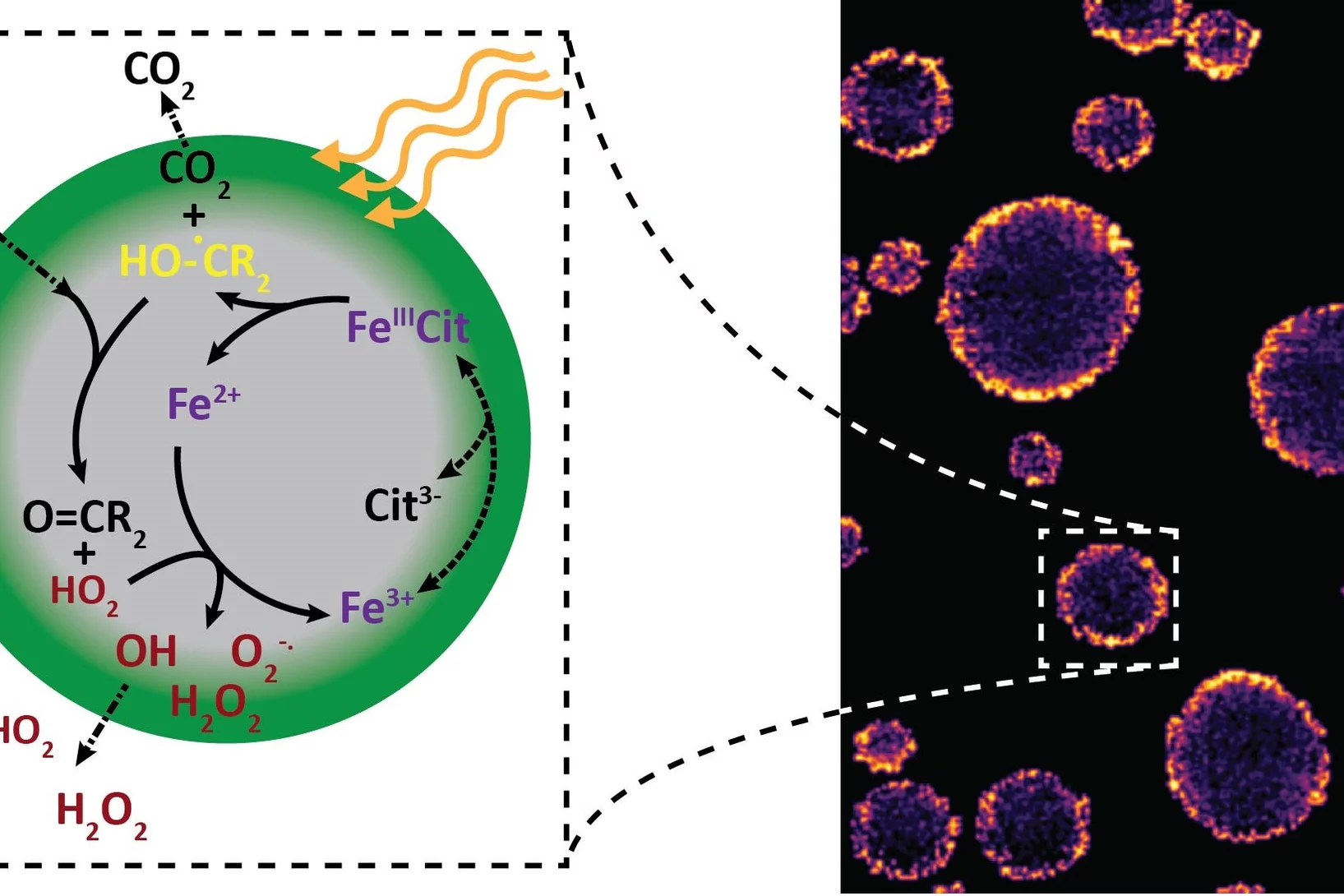Looking for photochemistry inside particles.
At the Swiss Light Source (SLS), a new photochemical reaction cell was developed for the X-ray microscope at the PolLux beamline. This allowed the researchers to mimic sunlight mediated chemical reactions in airborne particles we normally inhale. Utilizing the new reaction cell, the X-ray microscope was used to image the interior of particles for the chemistry that produced a high concentration of persistent carbon centered radicals (CCR) and reactive oxygen species (ROS), which are harmful compounds when inhaled and can cause damage in the respiratory tract. Two main factors were 1) a very high particle viscosity that effectively locks the CCRs in a glass-like state and 2) oxygen deficiency, or anoxia, to prevent smaller ROS to be formed with a shorter lifetime that easily diffuse out of the particle before inhalation. When relative humidity in air is <60%, particles can become highly viscous or even glass-like, which drastically reduces the mobility of all molecules. Although sunlight induced radical formation is likely to be unhindered, high viscosity would instead inhibit molecular diffusion and block oxygen from accessing the particle interior. This leads to preservation of large amounts of radicals. Amazingly, this may apply to all organic light absorbing atmospheric compounds making radical abundance and persistence an unforeseen issue until now.
Particles composed of citric acid and iron were investigated as a model for iron containing organic particles. About 1 in 20 airborne particles contain iron in urban areas at a significant concentration as identified by previous studies. The oxidation state of iron was mapped across individual particles using X-ray spectromicroscopy to reveal where photochemical reactions, oxidation and molecular diffusion took place inside. Oxidation and formation of ROS took place rapidly, but surprisingly, only near the particle surfaces, i.e. an oxidized reaction front extending only hundreds of nanometers was directly observed. This was entirely due to the rapid depletion of oxygen in the particle due to slow molecular transport and fast reaction cycling. In addition to X-ray microscopy, the researchers used an electrodynamic balance (collaboration with ETHZ) and a coated wall flow tube reactor to study these radical forming particles and constrain the overall reactive cycle and the production and release of radicals to air.
Despite that the particles under investigation were in air with abundant amounts of oxygen, the only way to explain the results is if oxygen was completely absent in the interior of these viscous photoactive airborne particles. PSI scientists conclude that it is the combination of photochemical radical production throughout particles and the reaction/slow transport of oxygen into the deeper regions within the particle that allows great numbers of radicals to persist. Previous studies using UV light exposure of ambient aerosol and cloud water reported a burst of radicals that quickly dissipates from ambient aerosol and cloud water immediately appearing when light was switched on. We have found this same burst in particles having high water content at high humidity, however, this high radical concentration will not go away when particles are highly viscous at low humidity. When inhaled, CCRs and ROS are harmful to our bodies and induce oxidative stress in lungs. Photochemically generated radicals that build up and persist may affect lifetimes of other aerosol-bound species such as pathogens or toxins, with health-related impacts. Exhaled particles of lung-lining fluid are composed of, in part, proteins, saccharides and iron, which may be highly viscous when dried in air, susceptible to photochemical radical buildup and impact pathogen viability. Common atmospheric brown carbon compounds such as imidazoles, quinone containing compounds or humic-like substances (HULIS) are photoactive and may limit O2 penetration similar to our findings if they produce sufficient radical numbers under conditions where low diffusion coefficients prevail. Secondary organic aerosol particles are highly viscous, and photochemical aging may generate additional radical compounds and follow-up products within them that are preserved. Therefore, we strongly suggest that radical production and persistence along with anoxia may be possible with all photoactive aerosol compounds given sufficient concentration and aerosol viscosity to cause anoxia due to both reaction and molecular transport limitations.
Contact
Dr. Peter A. Alpert
Project Scientist
Paul Scherrer Institute PSI, 5232 Villigen PSI, Switzerland
Telephone: +41 56 310 3934; E-mail: peter.alpert@psi.ch
Prof. Dr. Markus Ammann
Head of the Surface Chemistry Group
Paul Scherrer Institute PSI, 5232 Villigen PSI, Switzerland
Telephone: +41 56 310 4049; E-mail: markus.ammann@psi.ch
Original Publication:
Title: Photolytic radical persistence due to anoxia in viscous aerosol particles
Authors: Peter A. Alpert, Jing Dou, Pablo Corral Arroyo, Frederic Schneider, Jacinta Xto, Beiping Luo, Thomas Peter, Thomas Huthwelker, Camelia N. Borca, Katja D. Henzler, Thomas Schaefer, Hartmut Herrmann, Jörg Raabe, Benjamin Watts, Ulrich K. Krieger and Markus Ammann
Journal: Nature Communications,
DOI: 10.1038/s41467-021-21913-x (2021).
Acknowledgement to:
This work was funded by the Swiss National Science Foundation (Grants 163074 and 188662) and by the European Union’s Horizon 2020 research and innovation program under the Marie Skłodowska-Curie grant agreement (No 701647). The PolLux endstation was financed by the German Ministerium für Bildung und Forschung (BMBF) through contracts 05K16WED and 05K19WE2.
Additional Information


